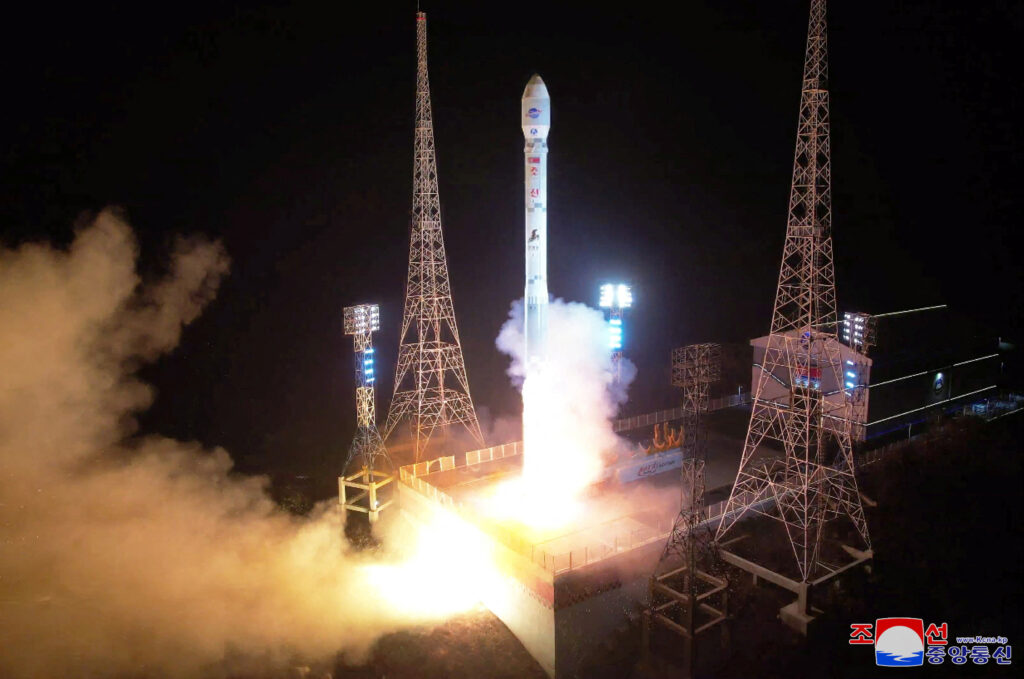
A rocket carrying a spy satellite Malligyong-1 is launched, as North Korean government claims, in a location given as North Gyeongsang Province, North Korea in this handout picture obtained by Reuters on November 21, 2023. KCNA via REUTERS
SEOUL/TOKYO -North Korea said it successfully placed its first spy satellite in orbit on Tuesday and vowed to launch more in the near future, defying international condemnation from the United States and its allies.
Officials in South Korea and Japan, which first reported the launch, said they could not immediately verify whether a satellite was placed in orbit. Pentagon spokesperson Sabrina Singh said the U.S. military was still assessing whether the launch was a success or not.
South Korea responded to the North Korean announcement by saying it would take steps to suspend parts of a 2018 inter-Korean agreement designed to lower military tensions, its Yonhap news agency reported.
Yonhap cited a South Korean National Security Council statement as saying the move would involve restoring reconnaissance and surveillance operations in the area around the military demarcation line between the countries.
North Korea’s KCNA state news agency said the Malligyong-1 satellite was launched on a Chollima-1 rocket from the Sohae satellite launch facility at 10:42 p.m. (1342 GMT) and entered orbit at 10:54 p.m. (1354 GMT). KCNA cited North Korea’s National Aerospace Technology Administration.
READ MORE: US Navy plane overshoots Hawaii runway: All 9 aboard escape injury
North Korea had earlier notified Japan it planned to send up a satellite between Wednesday and Dec. 1, after two failed attempts to launch what it called spy satellites earlier this year.
U.S. National Security Council spokesperson Adrienne Watson called the launch “a brazen violation of multiple U.N. Security Council resolutions,” and said it “raises tensions, and risks destabilizing the security situation in the region and beyond.”
U.S. State Department spokesperson Matthew Miller said the launch employed ballistic missile technology U.N. resolutions ban North Korea from using.
Tuesday’s launch would be the first since North Korean leader Kim Jong Un met Vladimir Putin at Russia’s modern space facility in September for a summit where the Russian president promised to help Pyongyang build satellites.
South Korean officials have said the latest launch attempt likely incorporated technical assistance from Moscow as part of a growing partnership that has seen North Korea send millions of artillery shells to Russia. Russia and North Korea have denied such arms deals, but are publicly promising deeper cooperation.
KCNA said Kim Jong Un personally observed the launch, which came just over a week before South Korea plans to send its first spy satellite into space on a Falcon 9 rocket operated by the U.S. company Space X.
North Korea’s space agency will send up multiple spy satellites in the near future to continue securing surveillance capabilities over South Korea and other regions of interest to North Korea’s armed forces, the report said.
“The launch of reconnaissance satellite is a legitimate right of (North Korea) for strengthening its self-defensive capabilities,” KCNA said, adding that it would enhance the country’s military preparedness in the face of its enemies’ “dangerous military moves.”
After the May launch attempt, South Korea retrieved the wreckage of the satellite from the sea and said an analysis showed it had limited use as a reconnaissance platform.
Marco Langbroek, a satellite expert at Delft University of Technology in the Netherlands, said while “observational” satellites launched by the North did achieve orbit in 2012 and 2016, it is not known whether they were ever truly functional and both burned up in the atmosphere this year.
Analysts say even a rudimentary satellite system could give North Korea its first capability to remotely monitor U.S., South Korean and Japanese troops.
Such a capability could allow the nuclear-armed North to target its weapons in the event of a war, but greater insight into allied troops movements could also help provide a degree of reassurance and stability, said Ankit Panda of the U.S.-based Carnegie Endowment for International Peace.
EMERGENCY ALARMS
South Korea’s military said it believed the rocket carried a reconnaissance satellite and was launched toward the south.
Over its emergency broadcasting system, the Japanese government told residents in Okinawa to take cover inside buildings or underground. It later said the rocket appeared to have flown over and past Okinawa towards the Pacific Ocean, and it lifted its emergency warning.
In brief remarks to reporters upon arriving at his office, Japanese Prime Minister Fumio Kishida repeated that North Korea’s launch was a violation of U.N. Security Council resolutions and a threat to the safety of Japanese citizens.
“We have lodged a stern protest and condemned North Korea in the strongest terms,” he said.
Earlier on Tuesday, Kishida said his country’s defence systems, including Aegis destroyers and PAC-3 air defence missiles, stood ready for any “unexpected situation” that arose.
Japan did not take steps to destroy the rocket, the Coast Guard said, citing the defence ministry.
South Korea, Japan and the United States had coordinated to pre-position Aegis destroyers that tracked the launch and shared data, South Korea’s military said.